4 Fun Facts About NYC & Long Island Spiders May. 19th 2014
4 Fun Facts About NYC & Long Island Spiders You might be inclined to think that something as reclusive and slow moving as a spider wouldn't like the big city. This assumption works for most animals and insects, but the opposite is true of spiders. They LOVE New York!

4 Fun Facts About NYC & Long Island Spiders
You might be inclined to think that something as reclusive and slow moving as a spider wouldn't like the big city. This assumption works for most animals and insects, but the opposite is true of spiders. They LOVE New York!
 Just as at-home in the middle of a metropolis as out in wild, open spaces, spiders don't discriminate when it comes to finding a place to string up a web.
Many types of spiders have evolved to suit city living in particular and would be lost if taken back to the wild. Here's a list of fun facts about NYC and Long Island Spiders you should know:
Just as at-home in the middle of a metropolis as out in wild, open spaces, spiders don't discriminate when it comes to finding a place to string up a web.
Many types of spiders have evolved to suit city living in particular and would be lost if taken back to the wild. Here's a list of fun facts about NYC and Long Island Spiders you should know:
#1. Spider's diet loves people
The most prevalent insects in your average major city are flies and mosquitoes, the former because they eat our trash and the latter because they drink our blood. These two species make up a significant portion of your average spider's diet. As such, spiders go where the food is, which in this case is where people are, and that means big cities. There are other factors at play here:- Buildings provide sturdy anchorage for hanging webs
- Cities often have vast expanses of warm, moist air available year-round
- Abandoned buildings, drain pipes, construction sites, and other empty lots provide predator-free hiding places
- Artificial lighting attracts bugs all night long when spiders are most active
#2. Approximately 3-6% of the world's population suffers from Arachnophobia (fear of spiders)
One explanation for fear of spiders�or arachnophobia�is that it's an evolutionary adaptation. There are many poisonous spiders in NY, and having an aversion to them served people well over the eons. If we thought spiders were cute and cuddly, we would have let them crawl all over us, bite us, and possibly kill us. One shudders at the thought. So the thinking is that we are genetically programmed to be afraid of spiders. As one who suffers from mild arachnophobia, I don't know if "afraid" is the right word; for me, it's more a feeling of profound disgust than crippling fear. There's something about the way spiders look, about the way they move, that I find thoroughly disgusting. And the bigger, the scarier�if I woke up with a tarantula sitting on my chest, a heart attack would not be out of the question. (And yet I'm not the least bit squeamish about blood and guts, and never get scared during scary movies�there's something about spiders.) Justin Timberlake, J.K. Rowling, and Selena Gomez also suffer from this affliction. In fact, between three and six percent of all people have Arachnophobia. But there's hope: like any phobia, this one's treatable. The most effective thing going is called systematic desensitization, which involves confronting spiders (or the thought of spiders) in a safe setting with a trained professional who attempts to break the pattern of physiological arousal and emotion that spiders cause.
"Spiders go where the food is, which in this case is where people are, and that means big cities."
-Rest Easy Pest Control
#3. Spiders are some of the most successful creatures on Earth
Spiders have adapted to nearly every habitat imaginable. They play a crucial role in many ecosystems (including keeping the insect population in check�at least they do some good!). Spider legs are hydraulic pumps. At least, that's the case with jumping spiders�who can jack up the fluid pressure in their legs and quickly unload it, jumping up to 50 times their height. Spiders can't see far. Despite having so many eyes, they are notoriously nearsighted. This makes sense because spiders generally spend their lives spinning webs and waiting for company. So they don't need hawk-like vision. There are 40,000 spider species, and all of them are carnivorous�or so we thought. A recent discovery has shown that one jumping spider that lives in the tropics�called Bagheera kiplingi, after the panther in The Jungle Book�mostly subsists on a sort of nutritious bud that grows from acacia plants. Spiders can lay up to 3,000 eggs at once. Females protect their eggs with silk sacs. All spiders make silk�all 40,000 species of them. Spiders are silk-smiths and can spin seven different types of silk�depending on their purpose or mood.#4. Spiders have engineering prowess
Spiders might be the most unpleasant-looking creatures on the face of the Earth, but you have to respect their engineering prowess. Spider webs are incredibly intricate, and they're made from one of the most amazing materials in the animal kingdom: spider silk. Gram for gram, spider silk is stronger than steel and way more pliable. Spiders store the precursors of their silk as proteins called spidroins, which have the consistency of a gel. And scientists from Sweden have recently learned how spiders turn this gel into the solid form of silk: as the gel moves through the spider's silk-making gland, the spiders use carbonic anhydrase to set up a steady pH gradient from 7.6 to 5.7. The carbonic anhydrase converts water and carbon dioxide into hydrogen and bicarbonate ions. This acidic change triggers chemical changes in the spidroins that lend themselves to the formation of tough spider-silk fibers. The scientists figured this stuff out by inserting microelectrodes into the spider's glands, which are only three-hundredths of an inch across.
"Spiders have adapted to nearly every habitat imaginable. They play a crucial role in many ecosystems (including keeping the insect population in check)."
-Rest Easy Pest Control
This research may sound trivial, but it has major implications. If we can figure out how to produce spider silk cheaply and en masse, it could change the world. Materials science is a fascinating field, and new materials often have profound effects on human society. According to one researcher, "If we could produce large amounts at a low price, there's no limit to what it could be used for." With a material that strong and that flexible, the sky may be the limit. This research may bring us a step closer to understanding exactly how spiders do it, and how we could replicate it.Spider Control in Long Island, NY
These tidbits may have piqued your interest, but we're pretty positive you still don't want to see any spiders in your NYC and Long Island house. If they do get into your house, lay eggs, and cause a problem, don't hesitate to call Rest Easy Pest Control. We know what to do, and we're more than happy to do it.*** Related Articles:
Related Articles:

















